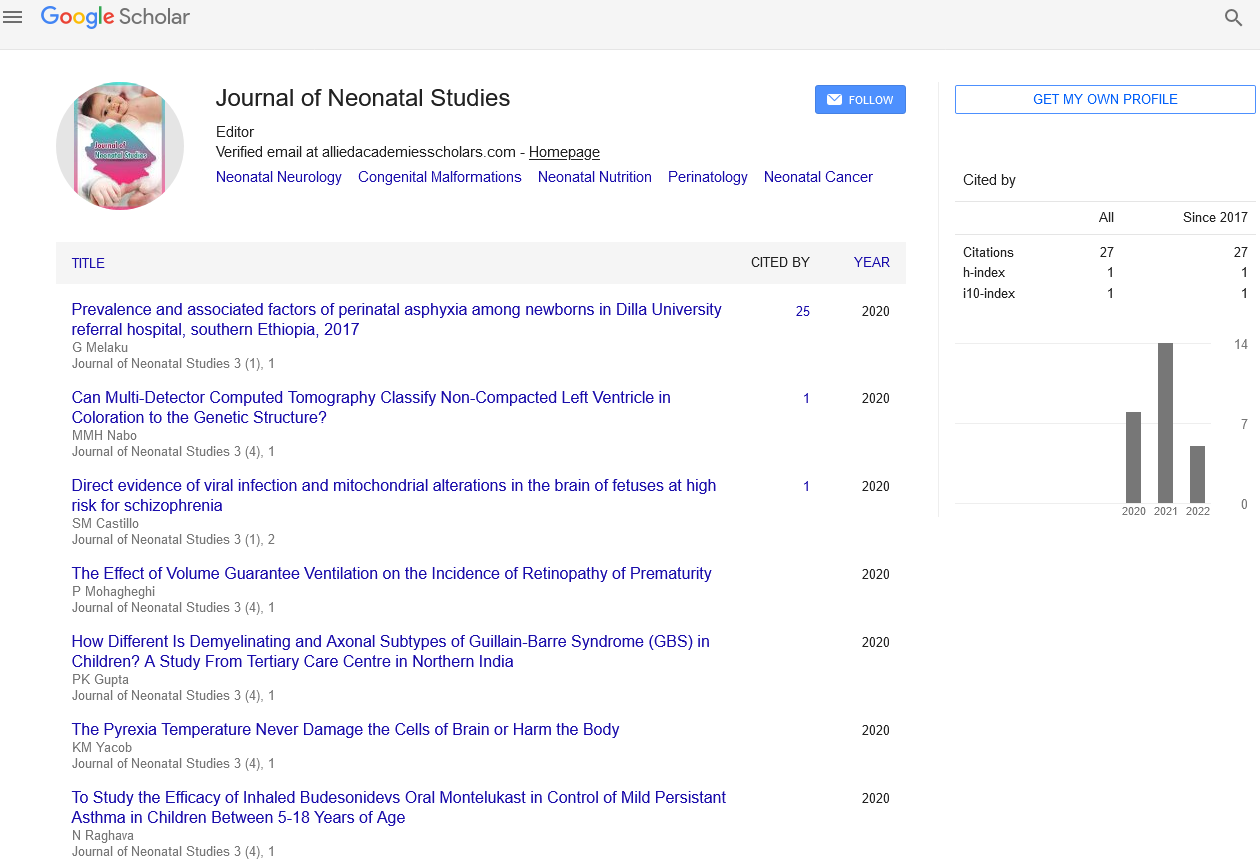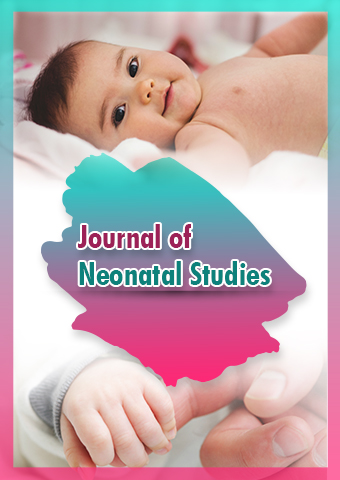Review Article - Journal of Neonatal Studies (2023) Volume 6, Issue 2
A Short Note on Perinatology
Panayides Andreas*
Department of Computer Science, University of Cyprus, Nicosia, Cyprus
Department of Computer Science, University of Cyprus, Nicosia, Cyprus
E-mail: andreas.p@edu.cp
Received: 01-Apr-2023, Manuscript No. JNS-23-95937; Editor assigned: 3-Apr-2023, PreQC No. JNS-22- 95937(PQ); Reviewed: 17-Apr-2023, QC No. JNS-22-95937; Revised: 21- Apr-2023, Manuscript No. JNS-22- 95937(R); Published: 28-Apr-2023; DOI: 10.37532/jns.2023.6(2).26-28
Abstract
Perinatology is a branch of obstetrics that focuses on the care of both the mother and fetus during pregnancy, childbirth, and the postpartum period. The goal of perinatology is to ensure a healthy pregnancy and delivery, and to manage any complications that may arise. Perinatologists are specialists in this field and are trained to handle high-risk pregnancies and complex medical conditions. They work closely with obstetricians, neonatologists, and other healthcare professionals to provide comprehensive care to pregnant women and their babies. Perinatology is a medical specialty that focuses on the care of women and their unborn babies during pregnancy, childbirth, and the postpartum period. The aim of perinatology is to ensure the health and well-being of both the mother and the baby, and to manage any complications that may arise during pregnancy or childbirth. In this article, we will discuss some of the common diseases and treatments associated with perinatology.
Keywords
Pregnancy • Perinatology • Childbirth • Labor
Introduction
The perinatology team typically includes a maternal-fetal medicine specialist, who is an obstetrician with specialized training in managing high-risk pregnancies, as well as a neonatologist, who specializes in caring for new-borns who need intensive medical care [1].
Perinatology is particularly important for women who have a preexisting medical condition such as diabetes, hypertension, or heart disease, or who develop complications during pregnancy such as preeclampsia, gestational diabetes, or preterm labor. Perinatologists use a variety of diagnostic tools and techniques to monitor the health of the mother and fetus throughout pregnancy. These may include ultrasound, fetal heart monitoring, amniocentesis, and other tests to evaluate the baby’s growth and development. In addition to managing medical conditions, perinatologists also provide counseling and support to pregnant women and their families. They help women understand their options for delivery, provide guidance on healthy lifestyle choices during pregnancy, and offer emotional support during what can be a challenging and stressful time.
Perinatology is a rapidly evolving field, and advances in technology and medical research are constantly improving the care that perinatologists can provide. For example, the use of noninvasive prenatal testing (NIPT) has revolutionized the way that certain genetic conditions are diagnosed during pregnancy, allowing for earlier and more accurate diagnosis and treatment [2].
Perinatology is a branch of obstetrics that focuses on the health of both mother and fetus during pregnancy, labor, and delivery. This field of medicine deals with the prevention, diagnosis, and treatment of conditions that can affect the mother and her developing baby. Perinatology aims to ensure the best possible outcome for both the mother and the child.
Discussion
Diseases in perinatology
There are several diseases that can affect the mother and her developing baby during pregnancy, labor, and delivery. These diseases can range from minor ailments to life-threatening conditions. Some of the most common diseases seen in perinatology are:
Preterm labor: Preterm labor is when a woman goes into labor before 37 weeks of pregnancy. This can lead to premature birth and other complications for the baby [3].
Preeclampsia: Preeclampsia is a condition that affects some pregnant women. It is characterized by high blood pressure and protein in the urine. If left untreated, it can lead to serious complications for both the mother and the baby.
Gestational diabetes: Gestational diabetes is a type of diabetes that affects some pregnant women. It occurs when the body cannot produce enough insulin to meet the demands of pregnancy. This can lead to high blood sugar levels, which can affect the health of both the mother and the baby.
Placenta previa: Placenta previa is a condition where the placenta lies low in the uterus, partially or completely covering the cervix. This can cause bleeding during pregnancy and delivery, which can be life-threatening for both the mother and the baby.
Preeclampsia
Preeclampsia is a serious condition that can occur during pregnancy, typically after the 20th week. It is characterized by high blood pressure and damage to organs such as the liver and kidneys. If left untreated, it can lead to seizures, stroke, and even death. Treatment for preeclampsia typically involves close monitoring of the mother and the baby, and in severe cases, delivery of the baby. Medications may also be used to control blood pressure and prevent seizures [4].
Gestational diabetes
Gestational diabetes is a type of diabetes that develops during pregnancy. It occurs when the body is unable to produce enough insulin to regulate blood sugar levels. Women with gestational diabetes are at an increased risk of developing type 2 diabetes later in life, and their babies are at an increased risk of developing complications such as macrosomia (large birth weight) and respiratory distress. Treatment for gestational diabetes typically involves monitoring blood sugar levels, making dietary changes, and in some cases, taking insulin.
Preterm labor
Preterm labor is when contractions start to occur before the 37th week of pregnancy. It is a serious condition that can lead to premature birth and complications such as respiratory distress, infections, and brain damage. Treatment for preterm labor may involve medication to stop contractions and bed rest. In some cases, delivery may be necessary to prevent further complications [5, 6].
Fetal growth restriction
Fetal growth restriction occurs when a baby is not growing at the expected rate during pregnancy. This can be caused by a variety of factors, including maternal health problems, placental problems, and genetic factors. Fetal growth restriction can lead to complications such as stillbirth, preterm birth, and developmental problems. Treatment for fetal growth restriction may involve close monitoring of the baby’s growth, and in severe cases, delivery of the baby.
Treatment in perinatology
Perinatology aims to prevent, diagnose, and treat diseases that can affect the mother and her developing baby during pregnancy, labor, and delivery. The treatment of perinatal diseases depends on the specific condition and its severity. Some common treatments include:
Medications: Medications can be used to treat a variety of conditions in perinatology. For example, medications may be used to stop preterm labor or to control high blood pressure in women with preeclampsia.
Bed rest: Bed rest may be recommended for women with certain conditions, such as preterm labor or placenta previa. Bed rest can help reduce the risk of complications and improve outcomes for both the mother and the baby.
Surgery: In some cases, surgery may be necessary to treat perinatal conditions. For example, a cesarean section may be necessary if the baby is in distress or if the mother has a condition that makes vaginal delivery unsafe.
Monitoring: Regular monitoring is an essential part of perinatal care. Monitoring can help detect problems early and allow for prompt treatment. Monitoring may include ultrasounds, fetal heart rate monitoring, and blood tests [7, 8].
Conclusion
Perinatology plays a critical role in ensuring the health and wellbeing of both mother and baby during pregnancy and childbirth. By working closely with a perinatology team, women with high-risk pregnancies can receive the specialized care they need to achieve a successful outcome. Perinatology is a vital medical specialty that plays an important role in ensuring the health and well-being of both mothers and babies during pregnancy and childbirth. The diseases and treatments associated with perinatology are varied and complex, and require the expertise of skilled healthcare professionals. If you are pregnant or planning to become pregnant, it is important to seek prenatal care and to discuss any concerns or questions you may have with your healthcare provider [9, 10].
Acknowledgement
None
Conflict of Interest
None
References
- Ndong A, Diallo A, Faye et al. Clinical photography in surgery: Knowledge, attitudes and practices in Dakar. Int J Surg. 3, 220-2 (2019).
- Solan MC, Calder JD, Gibbons CE et al. Photographic wound documentation after open fracture. Injury. 32, 33-5 (2001).
- Wade FA, Oliver CW, McBride K. Digital imaging in trauma and orthopaedic surgery: is it worth it? J Bone Joint Surg Br. 82, 791-4 (2000).
- Regulation GDP. Regulation EU 2016/679 of the European Parliament and of the Council of 27 April 2016. Official Journal European Union. (2016).
- Cheung A, Al-Ausi M, Hathorn I et al. Patients’ attitudes toward medical photography in the emergency department. Emerg Med J. 22, 609- (2005).
- Harting MT, DeWees JM, Vela KM et al. Medical photography: current technology, evolving issues and legal perspectives. Int J Clin Pract. 69, 401-9 (2015).
- Hsieh C, Yun D, Bhatia AC et al. Patient perception on the usage of smartphones for medical photography and for reference in dermatology. Dermatol Surg. 41, 149-54 (2015).
- Lau CK, Schumacher HH, Irwin MS. Patients' perception of medical photography. J Plast Reconstr Aesthet Surg. 63, e507-11 (2010).
- Accetta JL, Schoenfeld J, Bitar C et al. Smartphones in Dermatology: Acceptance of Smartphone Photography by the Informed Patient. Dermatol Surg. 46, 1131-3 (2020).
- Jordan MC, Jovic S, Gilbert F et al. Smartphone-based photographic wound documentation improves the quality of medical accounting in orthopedic and plastic surgery. Unfallchirurg. (2020).
Indexed at, Google Scholar, Crossref
Indexed at, Google Scholar, Crossref
Indexed at, Google Scholar, Crossref
Indexed at, Google Scholar, Crossref
Indexed at, Google Scholar, Crossref
Indexed at, Google Scholar, Crossref
Indexed at, Google Scholar, Crossref
Indexed at, Google Scholar, Crossref

